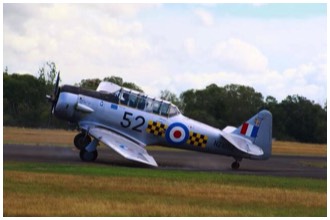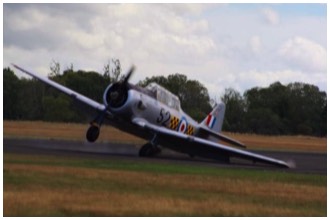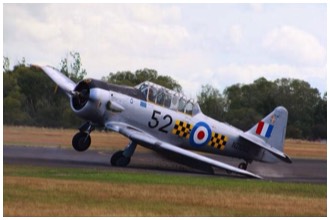How to avoid that T6 ground Loop
A very informative account of T6 Ground loops from Kent Beckham of Vintage Wings of Canada.
What is a ground loop?
Ground loops result from the loss of directional control. What flight control is most critical for directional control? The rudder you say! What if I told you that the reason Harvards ground loop is because of a lack of aileron usage?
Any Harvard Ace will tell you that you need right rudder and plenty of right rudder trim for take off, but that’s only half the story. You need left rudder for landing. The vertical fin is offset such that full right rudder is not required for take off and none should be required for normal cruise. Since this fin is not adjustable in flight, it still commands the aircraft to the right when the power is brought back to idle for landing. (Not landing at idle power? Bad pilot – very bad pilot – you are now rendering your landing gear warning horn useless, and increasing the runway length required. How are you ever going to know how to land when the fan quits?) In order to prevent the aircraft from going right into the rhubarb, left rudder is required when the throttle is closed.
Do you close the throttle at round out? This requires you to flare, add left rudder, and correct for any crosswind with aileron, all at the same time. You have trouble walking and talking on a cell phone at the same time, but try to control all three axes in gusty crosswinds and you wonder why the landing isn’t working out as well as you had hoped.
It doesn’t matter that you slid it on slicker than shoe soles on wet ice, nor that the track and heading are aligned, for as you slow down the airflow over the ailerons decreases, reducing their effectiveness, resulting in more lift caused by the dihedral in the upwind wing and an unrelenting crosswind. As the aircraft starts to weather cock into wind the weight is transferred to the downwind gear leg increasing its traction but – whoa – it’s no longer aligned with the runway. You stomp on full downwind rudder and maximum brake to stop the swerve. If it ever takes hold, your window of opportunity to release it is extremely small, chances are that you’ll over correct and spin out into the beans scaring the worms silly with a wing tip. Speaking of which, a tip touch with its wing span arm and moment will instantly pivot you sideways.
If (The English language does no justice to a word so mighty by representing it with only two letters.) you applied full aileron and some opposite rudder you would have made a nice save. Better yet, if (Oh – so powerful a word!) you eased in full aileron as the speed diminished you’d be taxiing to the hangar floating in the cockpit swelling with pride – bound only to earth by the seat belts; instead you’ll need to try and relax the sphincter muscle to remove the seat cushion.
I feel a little out of place preaching about something that I’ve never experienced. I spent ten consecutive years in the back seat (several out of Woodstock in the short runway days) instructing on Harvards. I have lost tail wheel steering, blown tail tires, and even landed with the whole thing missing – but I have never experienced a ground loop. Touch wood, (kind of hard to do in a metal airplane) or better yet… use aileron!


